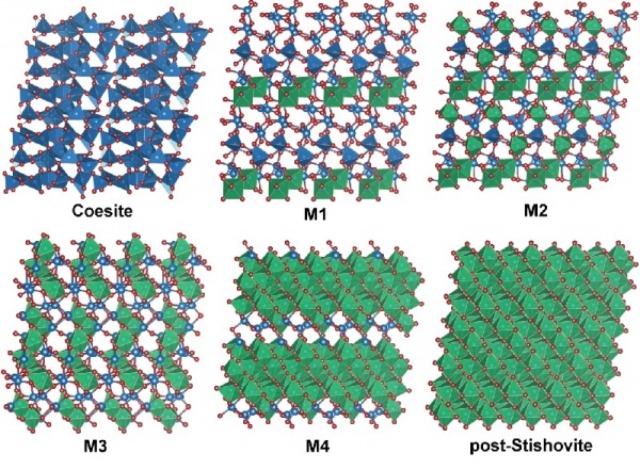Mar 24 2015
Researchers at Carnegie have led a study that has discovered five new forms of silica at room temperature, and under conditions of extreme pressure.
 A simulated visual representation of the structural transition from coesite to post-stishovite. The silicon atoms (blue spheres) surrounded by four oxygen atoms (red spheres) are shown as blue tetrahedrons. The silicon atoms surrounded by six oxygen atoms are shown as green octahedrons. The intermediate phases are not filled in with color, showing the four stages that are neither all-blue like coesite nor all-green like post-stishovite. This image is provided courtesy of Ho-Kwang Mao.
A simulated visual representation of the structural transition from coesite to post-stishovite. The silicon atoms (blue spheres) surrounded by four oxygen atoms (red spheres) are shown as blue tetrahedrons. The silicon atoms surrounded by six oxygen atoms are shown as green octahedrons. The intermediate phases are not filled in with color, showing the four stages that are neither all-blue like coesite nor all-green like post-stishovite. This image is provided courtesy of Ho-Kwang Mao.
Silica or silicon dioxide is a major component of the Earth. It is one among the most abundantly available materials. Silica in its quartz crystalline form is widely used in a range of applications, including glass, cement, microchips and toothpaste. The quartz crystalline form of silica is quite popular among non-scientists.
Scientists who perform studies related to conditions mimicking the Earth, such as the transition that takes place between different chemical phases under conditions considered to be extreme, utilize silica in its various high-pressure forms.
The first high-temperature, high-pressure form of silica that was discovered is called as coesite. It is of a different phase or form. Coesite is made up of silicon atom building blocks and four oxygen atoms surround them. On application of greater temperature and pressure, this material transforms into stishovite, which is a denser form consisting of silicon atoms that have six oxygen atoms surrounding them.
In order to understand the pressure gradient existing in deep Earth, geoscientists have been interested in knowing about the transition that occurs between these phases and the four-to-six atom configuration shift has also interested them. A post-stishovite form, which is a phase of silica that is under even higher-pressure, has also been found to exist.
A chemical phase of a substance is considered to be a state that has a uniform and distinctive state of molecules. Transition in phase can take place when changes in external pressure, temperature or other conditions take place. This is similar to the manner in which water boils into steam or freezes into ice.
The team of researchers included Carnegie’s Qingyang Hu, Yue Meng, “Dave” Mao, Ho-Kwang, Jinfu Shu, and Wenge Yang. They demonstrated that a single coesite crystal transformed itself into four co-existing crystalline phases and later recombined into a denser single phase. This is the newly discovered fifth phase, which is called as post-stishovite. This transformation occurred under a pressure ranging from 257,000 to 523,000 times that of the normal atmospheric pressure (26GPa-53Gpa). This transition has been achieved at room temperature and not at the extreme temperatures that exist in deep Earth.
Earlier, it was considered that the intermediate phase was amorphous. This would mean that it would not have a crystalline structure’s long-range order. However, superior x-ray analytical probes were used in the current study and they showed that there were four, well-crystalized and unique phases of silica that did not have amorphization. The research team conducted advanced theoretical calculations that enabled detailed explanations of coesite’s transition path to the four crystalline phases and then to the post-stishovite phase.
“Scientists have long debated whether a phase exists between the four- and six-oxygen phases,” Mao said. “These newly discovered four transition phases and the new phase of post-stishovite we discovered show the missing link for which we’ve been searching.”
The other co-authors of the paper are Adam Cadien of George Mason University; and Howard Sheng who is of the George Mason University and of the Center for High Pressure Science and Technology Advanced Research in Shanghai.
The researchers have published their study in Nature Communications.